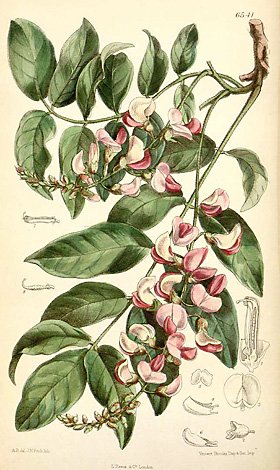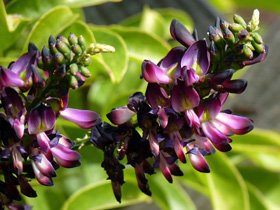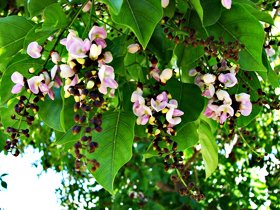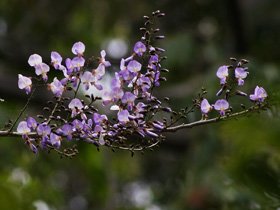





Summer or evergreen wisteria isn’t really a wisteria, nor is it always evergreen. However, it does boast striking 4 to 8-inch clusters of purple and magenta blooms during the hottest months.
 Part of a family of at least 150 species of trees and vines, evergreen wisteria (Millettia reticulata) is far and away the most popular millettia—in the U. S., at least. Clambering to 25 or 30 feet and less invasive than real wisteria, it also blooms for much longer. Once established, it reportedly can flower for most of the summer and early fall if its fading clusters are snipped off, probably mid-summer to fall in the cooler regions of its range.
Part of a family of at least 150 species of trees and vines, evergreen wisteria (Millettia reticulata) is far and away the most popular millettia—in the U. S., at least. Clambering to 25 or 30 feet and less invasive than real wisteria, it also blooms for much longer. Once established, it reportedly can flower for most of the summer and early fall if its fading clusters are snipped off, probably mid-summer to fall in the cooler regions of its range.
Hardy in USDA zones 8 through 11, the vine may survive in protected spots in Zone 7 as well. Don’t be alarmed if the supposedly evergreen wisteria drops all of its pinnate but somewhat leathery foliage during winter, as it should re-sprout fresh leaves in spring.
 Like most legumes, it sets its own nitrogen and doesn’t need much fertilization. So it requires only moist and moderately rich soil in full sun, plus a support on which to climb.
Like most legumes, it sets its own nitrogen and doesn’t need much fertilization. So it requires only moist and moderately rich soil in full sun, plus a support on which to climb.
Called Ji Xue Teng, or “chicken blood vine” in its native China for its red sap, it--or some other species of millettia--was discovered in the early 1800s by Charles Millett of the East India Company and the genus subsequently named for him. He apparently was in the habit of sending interesting plants to his friend Professor William J. Hooker, who eventually would become director of the Royal Botanic Gardens at Kew.
 A source of the insecticide called rotenone, millettia should theoretically be insect-proof, but I wouldn’t count on that, as insects routinely eat many of my most poisonous plants! According to the comments I’ve read, the attractiveness or lack thereof of evergreen wisteria’s scent is all in the nose of the sniffer. I’ve seen that odor described as “similar to Confederate jasmine” or more cedar, camphor, or even chemical-like. Those blooms are followed by 6-inch pods which ripen to black when filled with 1/2-inch seeds.
A source of the insecticide called rotenone, millettia should theoretically be insect-proof, but I wouldn’t count on that, as insects routinely eat many of my most poisonous plants! According to the comments I’ve read, the attractiveness or lack thereof of evergreen wisteria’s scent is all in the nose of the sniffer. I’ve seen that odor described as “similar to Confederate jasmine” or more cedar, camphor, or even chemical-like. Those blooms are followed by 6-inch pods which ripen to black when filled with 1/2-inch seeds.
The Millettia family also includes the Australian wisteria vine (Millettia megasperma), as well as pongam (Millettia pinnata). The latter is invasive, so you’ll probably want to avoid it, even though its bicolor lavender and pink flowers make it a pretty weed! The hausa tree (Millettia thonningii) boasts graceful lavender flowers.
 To start millettias from seeds, soak those seeds in water for 24 hours before planting them about 1/2 inch deep in a combination of seed-starting mix and sand. If kept at temperatures in the 70s Fahrenheit, the seeds should sprout in two to four weeks.
To start millettias from seeds, soak those seeds in water for 24 hours before planting them about 1/2 inch deep in a combination of seed-starting mix and sand. If kept at temperatures in the 70s Fahrenheit, the seeds should sprout in two to four weeks.
Should you prefer a real wisteria, I can recommend Wisteria macrostachya 'Blue Moon' which performs profusely for me on the northeast corner of our garage here in Zone 5, usually in early June. Although it is supposed to re-bloom later in the year, it does so in a less than enthusiastic manner, so I wouldn’t count on that.
If you want wisteria in summer, therefore, I would advise you to give millettia a try. Or perhaps you could plant both season's wisterias on the same arbor to flummox your friends!
Photos: Millettia reticulata thumbnail is by Kauai17 from the Dave's Garden PlantFiles. Millettia megasperma image is by A. Barnard from an 1881 edition of Curtis's Botanical Magazine, courtesy of plantillustrations.org. Millettia reticulata photo is by Mathesont and Millettia pinnata image by Tatters, both courtesy of Flickr Creative Commons and this license, and Millettia thonningii photo by Magnus Mansloe, courtesy of Wikimedia Commons and this license.
Copyright © www.100flowers.win Botanic Garden All Rights Reserved